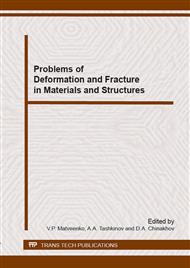p.97
p.105
p.113
p.121
p.131
p.139
p.147
p.155
p.163
Numerical Method for Solving the Problem of Thermomechanics of Polymeric Environment in Conditions of Phase Transition
Abstract:
A methodology and a numerical algorithm of solving boundary problems of mechanics of deformable crystallizing elastic polymer media have been developed. A class of problems describing processes taking place in polymer products during their manufacturing is considered. Due to the significance of shrinking deformations the problem is considered within finite deformations theory. Constitutive relations are built on base of Peng-Landel potential. A ‘weak’ variation problem statement based on Galerkin approach is used. The offered algorithm is based on linearization methodology when small deformations are applied to finite ones. Deformation process is considered as a sequence of transitions through intermediate configurations. This approach makes possible to bring the received solution to the sequence of linearized boundary problems for which effective numerical algorithms have been designed. Numerical procedure is based on the technology of finite element method. Increments of displacements on the considered time step are taken to be nodal unknowns. The offered algorithm is applied to solution of the problem concerning the polyethylene pipe deformation during its manufacturing. Main advantages of the proposed algorithm have been defined.
Info:
Periodical:
Pages:
139-145
Citation:
Online since:
October 2015
Authors:
Price:
Сopyright:
© 2016 Trans Tech Publications Ltd. All Rights Reserved
Share:
Citation:


